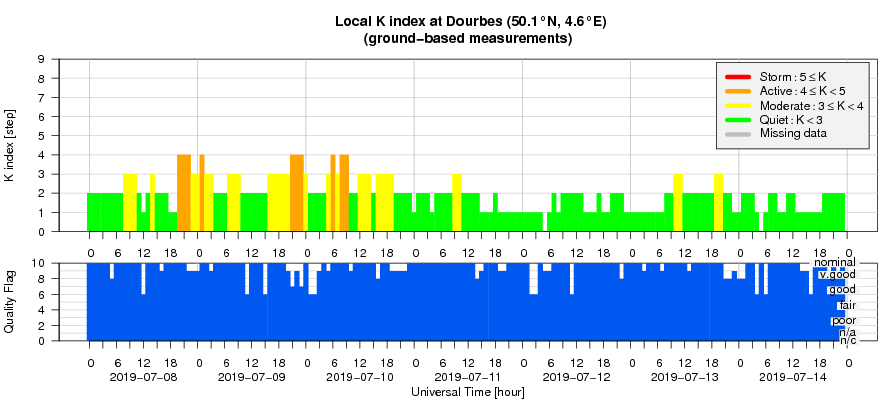- Table of Content
- 1.Agora: a new s...
- 2.Review of sola...
- 3.PROBA2 Observa...
- 4.The Internatio...
- 5.Review of geom...
- 6.Geomagnetic Ob...
- 7.The SIDC Space...
- 8.Review of iono...
2. Review of solar activity
3. PROBA2 Observations (8 Jul 2019 - 14 Jul 2019)
4. The International Sunspot Number
5. Review of geomagnetic activity
6. Geomagnetic Observations at Dourbes (8 Jul 2019 - 14 Jul 2019)
7. The SIDC Space Weather Briefing
8. Review of ionospheric activity (8 Jul 2019 - 14 Jul 2019)
Agora: a new supplement for JSWSC
The Journal of Space Weather and Space Climate (JSWSC - https://www.swsc-journal.org/ ), published by EDP Sciences, announces the launch of a new supplement titled "Agora". The Agora, a term which denoted in ancient Greek an assembly place for various aspects of public life including intellectual exchange and debate, will be the place for the space weather community to discuss, evaluate and distribute non-traditional scientific output in the field of space science and space climate, such as public outreach papers and historical accounts.
The first article published in the Agora section analyses magnetic storms recorded in 1848 and 1872 in the old Clementinum (Prague) and Greenwich (UK) observatories. These events were marked by spectacular auroras recorded by several authors. It is available at the dedicated Agora webpage https://www.swsc-journal.org/agora
In an Editorial published recently in JSWSC, the Editors explain the importance of publishing this type of scientific output, and the need to design a new way to evaluate it.
"The decision to create a supplement to the JSWSC came from our difficulties to evaluate some articles. All Education and Public Outreach papers and papers on historical observations resulted in tense discussions within the Editorial Board, with final decisions always frustrating for some of the editors," write the Editors. "In consequence, papers in a new supplement should not be subject to the same review process as in the regular issue of JSWSC."
The creation of a supplement to the journal was discussed with the Associate Editors of JSWSC. These discussions resulted in the specification of the characteristics of the supplement which would accommodate publications fundamentally different from the journal's regular research, technical, and review papers. Agora will publish papers on Education and public outreach, Historical space weather events and observations, Commentaries, Meeting reports and Project reports.
The articles for the Agora supplement will be internally reviewed by at least four editors, among them the Editors in Chief and the Editorial Advisor. In order to meet the needs of potential contributors, the new articles in the supplement will be indexed similarly to regular JSWSC papers, will receive a DOI and will be citable. However, the supplement will clearly be marked as evaluated by members of the editorial board as opposed to external peer reviewers.
As with all other articles published in the gold open access Journal of Space Weather and Space Climate, Agora articles are published as soon as possible after acceptance, in the current volume. They are also collated in a special Agora collection accessible at https://www.swsc-journal.org/agora All articles published in JSWSC are freely accessible to all and distributed under the terms of the Creative Commons Attribution License (CC-BY 4.0).

Review of solar activity
One active region was visible on the solar disc, NOAA 2744, only until July 9 when it decayed into a plage. No flares were observed during the week. There were no Earth-directed coronal mass ejections (CMEs) and the greater than 10 MeV proton flux was at nominal levels throughout the week.
Underneath are extreme-ultraviolet images from SDO/ AIA 193 showing a small eruption early on 14 July near the plage remnant of active region NOAA 2744. The image to the left shows the decayed AR in the southwest (lower right) solar quadrant just prior to the eruption. The image to the right was taken 2.5 hours later and shows the post-eruption coronal loops and some small coronal dimming to the upper right of the eruption site. No x-ray flares were associated with this event, and an accompanying weak CME was directed away from the Earth.
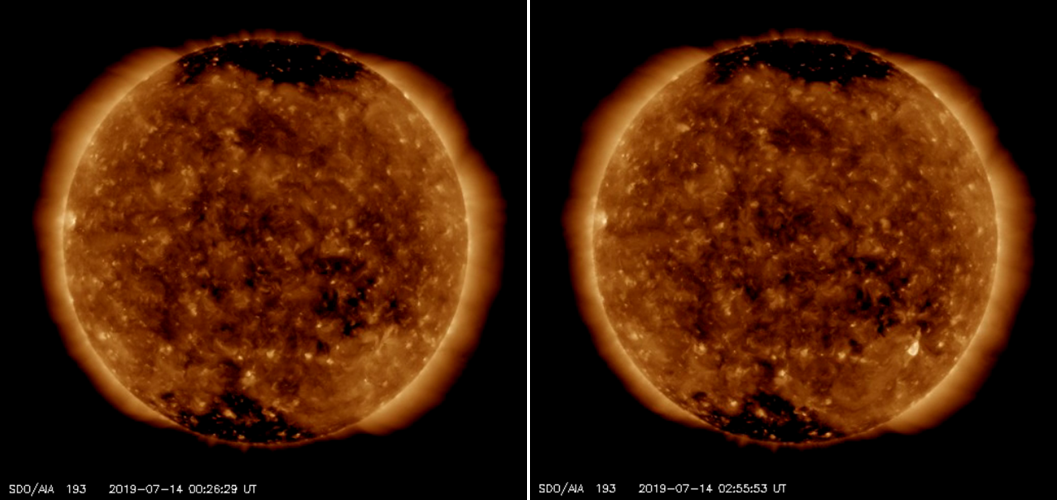
PROBA2 Observations (8 Jul 2019 - 14 Jul 2019)
Solar Activity
Solar flare activity remained very low during the week.
In order to view the activity of this week in more detail, we suggest to go to the following website from which all the daily (normal and difference) movies can be accessed: http://proba2.oma.be/ssa
This page also lists the recorded flaring events.
A weekly overview movie can be found here (SWAP week 485): http://proba2.oma.be/swap/data/mpg/movies/weekly_movies/weekly_movie_2019_07_08.mp4
Details about some of this week's events can be found further below.
If any of the linked movies are unavailable they can be found in the P2SC movie repository here: http://proba2.oma.be/swap/data/mpg/movies/
Sunday Jul 14
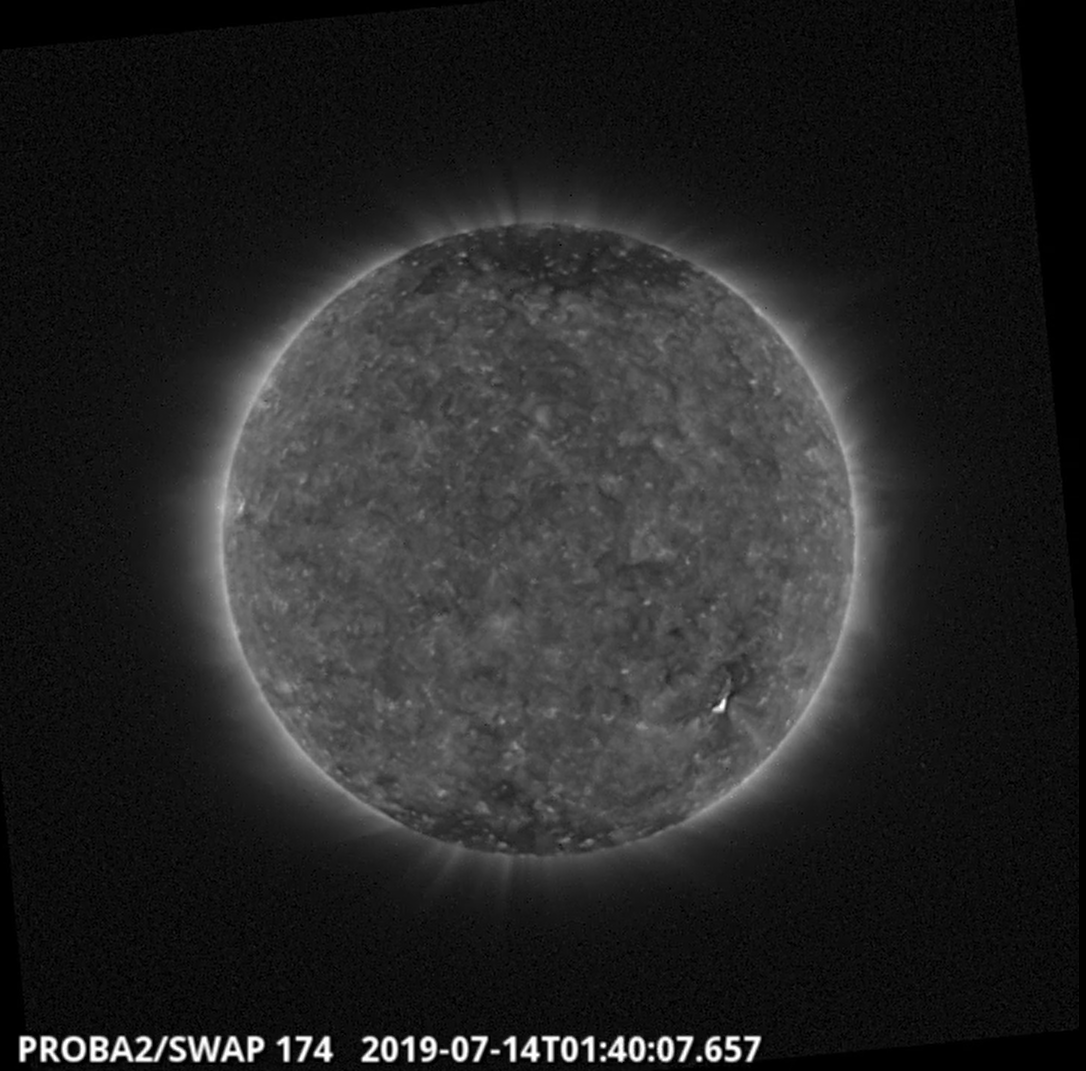
A dimming and subsequent bright loop formation, probably associated with a small eruption, was observed by SWAP on 2019-Jul-14 and is visible in the south-west quadrant of the solar disk in the SWAP image above taken at 01:40 UT.
Find a movie of the event here: http://proba2.oma.be/swap/data/mpg/movies/20190714_swap_movie.mp4 (SWAP movie) and here: http://proba2.oma.be/swap/movies/20190714_swap_diff.mp4 (SWAP difference movie).
The International Sunspot Number
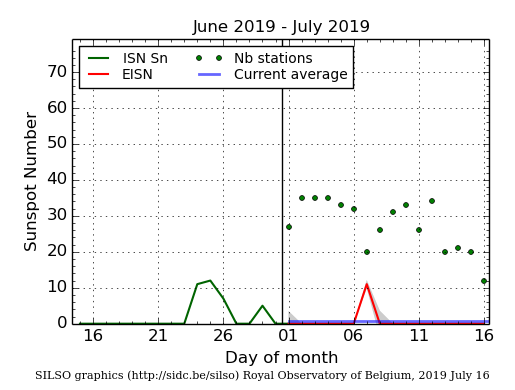
The daily Estimated International Sunspot Number (EISN, red curve with shaded error) derived by a simplified method from real-time data from the worldwide SILSO network. It extends the official Sunspot Number from the full processing of the preceding month (green line). The plot shows the last 30 days (about one solar rotation). The horizontal blue line shows the current monthly average, while the green dots give the number of stations included in the calculation of the EISN for each day.
Review of geomagnetic activity
On July 8 at 18:38 UT, a shock was detected by SOHO (and ACE). It was associated with a stealth CME (origin not confirmed) and with the arrival of an expected high speed stream from a positive polarity coronal hole. Wind speeds reached values up to 660 km/s and the interplanetary magnetic field reached field strengths up to 13 nT (with Bz going to -11 nT). As a consequence, geomagnetic conditions reached active levels (K = 4) locally at Dourbes (on July 8, 9 and 10), and minor storm conditions at planetary scale (Kp = 5, on July 9 and 10).
Underneath a picture in extreme-ultraviolet by SDO/AIA 211 of the positive polarity coronal hole while it was transiting the Sun's central meridian on 6 July.
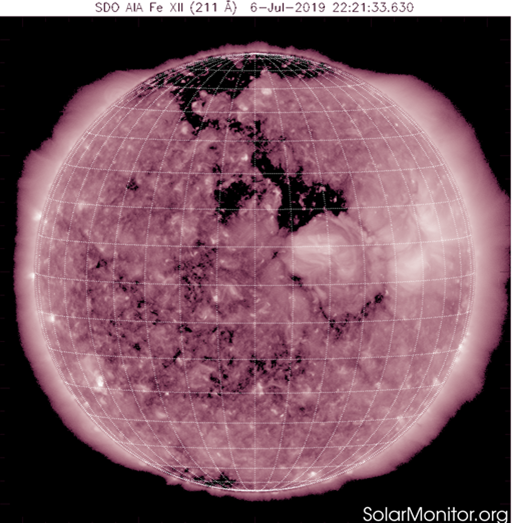
The SIDC Space Weather Briefing
The Space Weather Briefing presented by the forecaster on duty from 8 to 14 July. It reflects in images and graphs what is written in the Solar and Geomagnetic Activity reports.
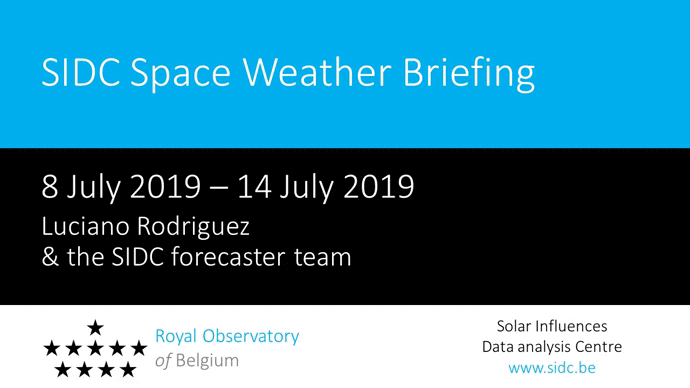
The pdf-version: http://www.stce.be/briefings/20190715_SWbriefing.pdf
The automatically running presentation: http://www.stce.be/briefings/20190715_SWbriefing.wmv
Review of ionospheric activity (8 Jul 2019 - 14 Jul 2019)
The figure shows the time evolution of the Vertical Total Electron Content (VTEC) (in red) during the last week at three locations:
a) in the northern part of Europe(N61°, 5°E)
b) above Brussels(N50.5°, 4.5°E)
c) in the southern part of Europe(N36°, 5°E)
This figure also shows (in grey) the normal ionospheric behaviour expected based on the median VTEC from the 15 previous days.
The VTEC is expressed in TECu (with TECu=10^16 electrons per square meter) and is directly related to the signal propagation delay due to the ionosphere (in figure: delay on GPS L1 frequency).
The Sun's radiation ionizes the Earth's upper atmosphere, the ionosphere, located from about 60km to 1000km above the Earth's surface.The ionization process in the ionosphere produces ions and free electrons. These electrons perturb the propagation of the GNSS (Global Navigation Satellite System) signals by inducing a so-called ionospheric delay.
See http://stce.be/newsletter/GNSS_final.pdf for some more explanations ; for detailed information, see http://gnss.be/ionosphere_tutorial.php
